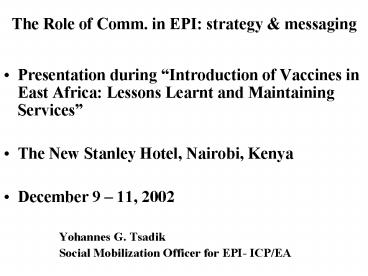The Role of Comm' in EPI: strategy - PowerPoint PPT Presentation
1 / 16
Title:
The Role of Comm' in EPI: strategy
Description:
Advocacy: Commitment for political, resources & policy support; Process of ... them speak), use humor, listen attentively, encourage your communicator to ... – PowerPoint PPT presentation
Number of Views:16
Avg rating:3.0/5.0
Title: The Role of Comm' in EPI: strategy
1
The Role of Comm. in EPI strategy messaging
- Presentation during Introduction of Vaccines in
East Africa Lessons Learnt and Maintaining
Services - The New Stanley Hotel, Nairobi, Kenya
- December 9 11, 2002
- Yohannes G. Tsadik
- Social Mobilization Officer for EPI- ICP/EA
2
Benefits of Comm. For EPI
- Quality active service delivery
- Well-planned comm. activity
- Ensures acceptance of service, sustains demand
- Facilitates raise in EPI coverage
- Facilitates the support by all possible
allies/partners - Reduces dropout rates
3
Benefits of Communication contd.
- Raises awareness/increase knowledge on benefits
of immunization preventable diseases in
general - Ensures the commitment of decision
makers/leadership - Helps achieve commitment, participation and
ownership of EPI program by community - Helps to reach every household even hard to reach
- Assists for improved service delivery (HWs)
- Assists in raising funds for EPI program
- Strengthens understanding between ICC/ MOH/Allies
4
Communication Analysis/objectives
- Behaviors caretakers bringing babies, carry
immunization cards, making immunization a
culture, HWs speaking to mothers - Communication Objectives Focus on specific
objectives, Ask what is the expected result?
realistic, measurable, time-bound - If properly worded/formulated will tell targets,
what action to take, when the behavior to occur,
tage to be influenced or changed to a desirable
behavior
5
Planning Comm. for Immunization
- Comm. strategy Advocacy/SM/Communication
- Advocacy Commitment for political, resources
policy support Process of Advocacy Gather
information and define your audience, build a
plan (objectives, timeline, budget), create
messages/materials, face to face meetings, etc. - Social Mobilization Building partnership, ie.
involvement of broad range of allies Process of
SM Organize initial meeting(s), determine
potential contribution, form committees, organize
events/activities
6
Comm. Strategy contd.
- Behavior change (Prog. Communication) Prog.
Comm. encourages behavior change among targets - Process for comm. for behavior change
- Define the problem thru analysis determine
comm. related solutions - Determine the appropriate target audience and
required message - Select appropriate strategy
- Implement strategy monitor activities
7
TYPES OF COMMUNICATION
- One can communicate in many ways mass, group or
individual or non-verbal - Most effective for behavior change is
interpersonal notably between caretakers and
service providers - Non-verbal communication is another way
- Body language, the expression on faces while
someone is talking, silence, eye contact, etc. - Good interpersonal communication non-verbal
communication by mobilizers is important because
he/she communicates with kinds of people
8
Interpersonal communication skills
- Important to make your point effectively
- Gives a chance for dialogue and leads to
understanding of each other - Be natural, show interest and pay attention,
Demonstrate sensitivity (sympathize with others,
let them speak), use humor, listen attentively,
encourage your communicator to express
themselves - nod, say yes or continue or I understand
- (Exercise)
9
Barriers to Communication
- Sometimes we do not get good results in EPI
perhaps because - communication was bad (channel, source, receiver,
content) or information misinterpreted - EPI may not be a priority for leadership during
advocacy or mothers did not understand - Lack of communication skills on the part of
service providers or the manager - Lack of participation by all concerned
10
Managing implementation of comm.activities
- Train HWs/allies/volunteers who are participating
in communication of EPI - Supervise comm. Activities monitor progress
within - specified time and make improvements
- Verify comm. materials are distributed and
reached where they are required most - Hold meetings to communicate progress discuss
constraints - Communicate evaluation results consensus
reached - Ensures focal point is appointed he/she is
responsible for comm. planning and implementing
activities, works as a member of ICC
11
Managing Comm. Activities contd.
- Ensure the formation of ICC sub-committee for
communication, very good if available at
sub-national level too formulate comm.
strategies for EPI - Integrate Comm. component in multi-year annual
PoA with activities (training, implementation
schedule, budget) - Measure your success by the involvement of CBOs
community members dialoguing with community to
decide on issues/solutions planning activities
availability of adequate proper information,
IEC materials, enhancing capacity building, etc.
12
Monitoring comm. activities
- Objectives addressed/achieved
- All groups reached (hard to reach)
- Appropriate channels utilized
- Message understood their effects measured
- Comm. Committees and integrated comm. plan
existed
13
Communication for New Vaccines
- Mostly technical but communication has role too
- Basic message may be immunization has improved
offers more protection for more diseases - More protection for the same visits and
injections - New antigens have virtually no side effects
- HWs need to perform new tasks so the
communication focus may be on them - They need to be trained on communication skills
Hepatitis B Hib are difficult to explain to
public, may be better to focus on benefits
details can lead to confusion
14
Recommended actions
- Spot check on material distribution
- Observe whether planned activities are carried
out - Review feedback from field
- Interview service providers on attitude change,
- knowledge practice
- Hold focus group discussions
15
Conclusion and Recommended Action contd.
- Comm. fails when seen as an activity and left
without owner so give ownership until
institutionalization is realized - To succeed in comm. interventions, plan well and
act accordingly Combat rumors - Make sure that ICC has a SOCOMOB sub-committee
and such committees at all levels - Avoid weak client/ caretaker relationships
- Focus more on interpersonal/group media, less on
mass media
16
THANK YOU -- Asante































